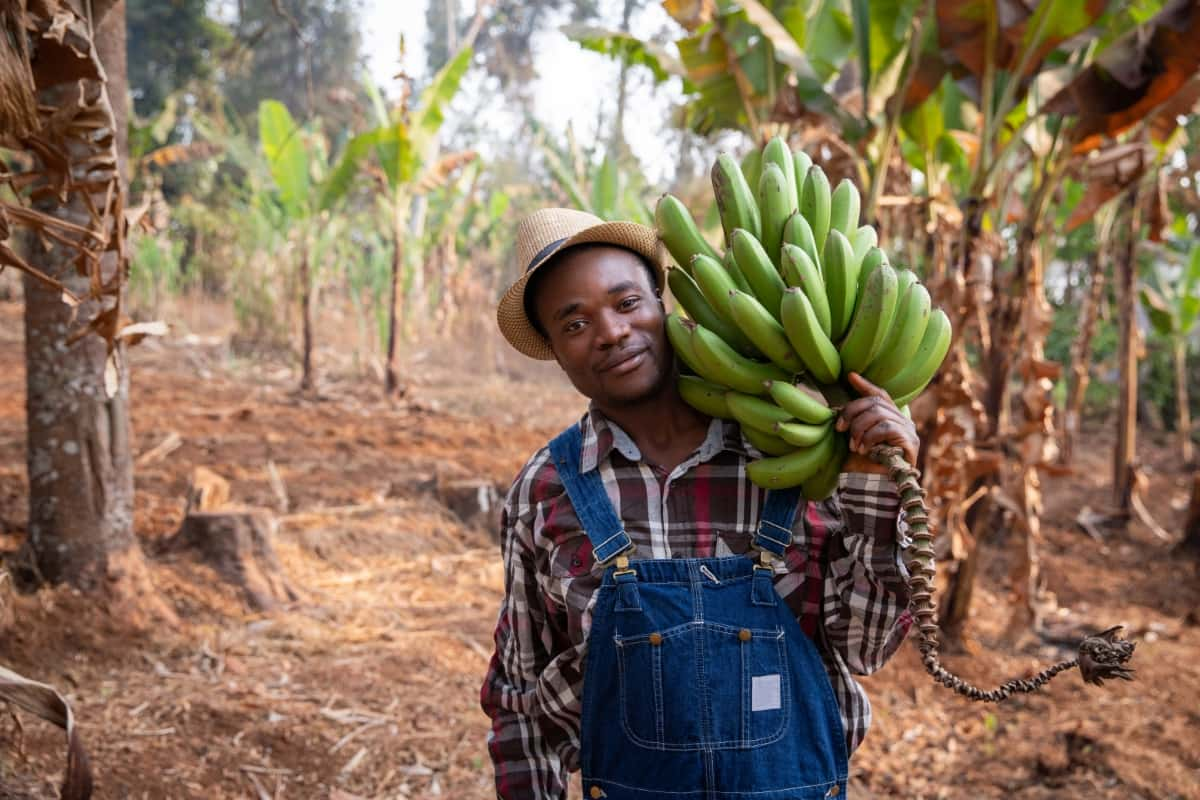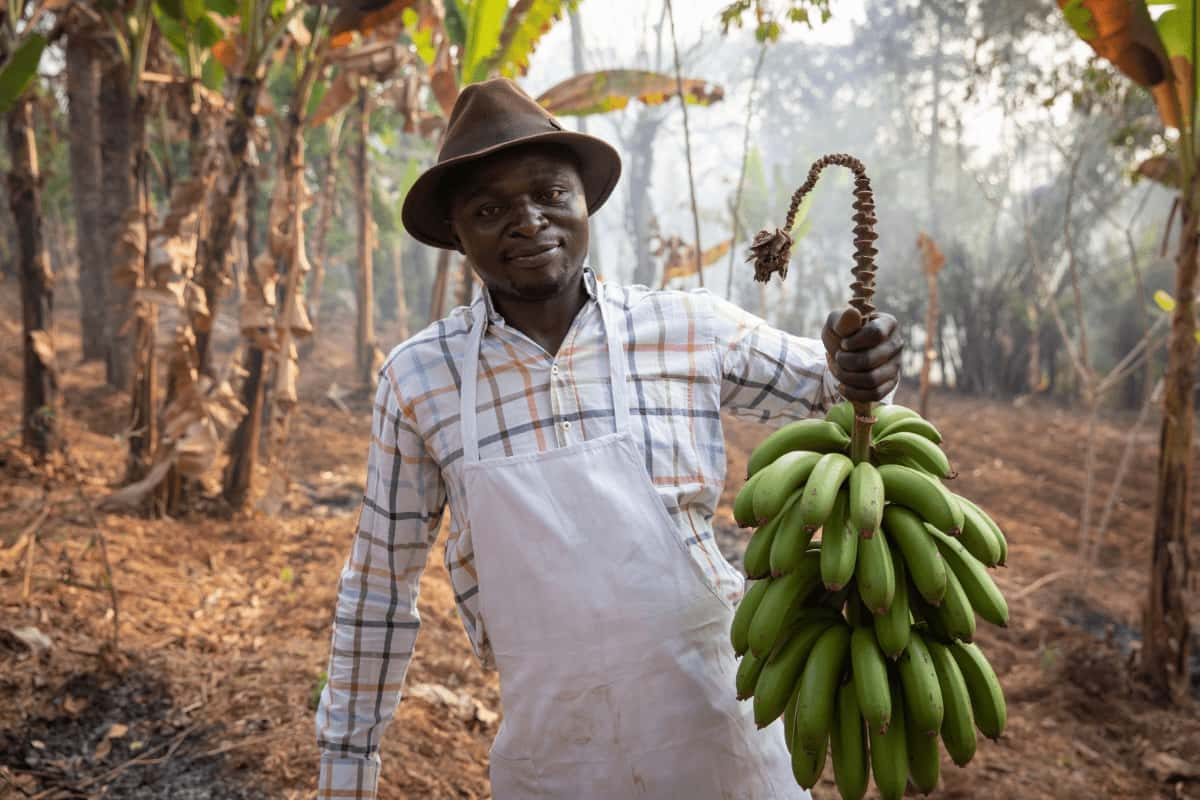Plantain, or Musa paradisiaca, is a versatile and nutritious fruit from the banana family. Unlike its sweeter cousin, the dessert banana, Plantains are typically larger and have a starchy consistency when cooked. You can get a bountiful harvest of deliciously wholesome organic Plantains with proper care and attention to detail throughout the growing process.

How to Grow and Care for Organic Plantain
Choosing the Right Organic Soil for Plantain Cultivation
Choosing the right organic soil for Plantain cultivation ensures healthy growth and bountiful harvests. Plantains thrive in well-draining, nutrient-rich soil that is slightly acidic with a pH range of 6 to 7.5. It’s also important to ensure proper drainage in your planting area. Plantains prefer moist but not waterlogged conditions. If you have heavy clay soils that tend to retain water, consider amending them with coarse sand or perlite to improve drainage.
Step-By-Step Instructions for Growing Organic Plantain
- Choose a suitable location: Find an area in your garden that receives full sun and has well-drained soil. Plantains thrive in tropical and subtropical climates, so ensure the temperature is warm enough for their growth.
- Planting process: Dig a hole deep enough to accommodate the root ball of your Plantain seedling or transplant. Place the plant gently into the hole and cover it with soil, ensuring no air pockets remain around its roots.
- Watering: After planting, thoroughly water your Plantain to help settle it into its new environment. Keep the soil consistently moist throughout its growth cycle.
- Provide organic fertilizers: To promote healthy growth, apply organic fertilizers around the base of your Plantain plants every few months during their growing season.
- Pest control measures: Monitor your plants regularly for signs of pests like aphids or mites. Use natural pest control ways like neem oil spray or introduce beneficial insects to keep them at bay.
- Disease prevention tips: Prevent diseases by providing adequate airflow between plants and avoiding over-watering, which can lead to fungal infections. The most common disease affecting Plantains is black sigatoka; organic fungicides may help prevent its spread.
- Harvesting time: Depending on various factors, including climate conditions, Plantains are usually ready for harvest 14-20 months after planting.
Information About Organic Plantain
| Common Name | Plantain tree |
| Botanical Name | Musa paradisiaca |
| Plant Type | Herbaceous perennial |
| Sun Exposure | Full sun |
| Soil Type | Moist, well-drained |
| Bloom Time | Summer |
Plantain Propagation Methods
How to grow Plantain from seed? Growing Plantains from seeds is a great option if you’re looking for a more cost-effective approach. However, remember that it can take quite some time for the seeds to germinate and grow into healthy plants. Patience is key when choosing this method.
On the other hand, using transplants is the way to go if you prefer a quicker start and more reliable results. Transplanting young Plantains allows you to skip the initial growth stage and start caring for established plants. This means faster fruit production and an overall smoother cultivation process. Regardless of which method you choose, make sure to provide adequate care during propagation. Keep your soil moist but not waterlogged, ensure proper sunlight exposure, and protect your plants from extreme temperatures or harsh weather conditions.
Organic Fertilizers for Optimal Plantain Growth
Choosing the right organic fertilizers for Plantain is essential for promoting healthy growth and abundant harvests. One popular choice for organic Plantain cultivation is compost. It enriches the soil with nitrogen, phosphorus, potassium, and micronutrients vital for plant growth. Another excellent option is worm castings or vermicompost. These are rich in beneficial microbes and nutrients that improve soil structure and fertility.
Worm castings also enhance nutrient absorption by plants while suppressing diseases. Seaweed extract is another fantastic natural fertilizer for Plantains. Consider using green manure crops like legumes or clover cover crops to naturally enrich your soil with nitrogen through their ability to fix atmospheric nitrogen into a usable form.
Proper Watering Techniques for Organic Plantain Plants
Aim for a slow, deep soak rather than shallow sprinkling when watering your Plantain plants. This encourages deep root growth and helps prevent moisture evaporation from the surface. Use a hose or watering can with a gentle spray nozzle to evenly distribute water around each plant’s base. During rainy seasons or periods of heavy rainfall, be mindful not to drown your Plantains in excessive moisture. If necessary, create small channels or trenches around each Plantain bed to redirect excess runoff away from their roots.
Natural Pest Control Methods for Organic Plantain
One effective pest control method is companion planting. You can deter pests naturally by strategically placing certain plants near your organic Plantain. For example, marigolds are known to repel nematodes and other soil-borne pests. Additionally, basil is a natural insect repellent that can help keep aphids and flies away from your Plantain. Another natural pest control method uses homemade sprays from common household ingredients like garlic or chili peppers.
In case you missed it: How to Grow and Care for Celebrity Tomatoes: A Step-By-Step Planting to Harvest Guide

These sprays act as deterrents for insects without harming the environment or beneficial insects in your garden. Introducing beneficial insects into your garden is also an effective way to control pests naturally. Ladybugs, lacewings, and praying mantises are all beneficial predators that feed on aphids and other harmful insects. Early detection allows you to take action promptly before the problem spreads.
Preventing Diseases and Common Issues in Organic Plantain Cultivation
It’s important to maintain good hygiene practices in your garden. Remove dead or decaying leaves regularly, as they can attract pests and harbor disease-causing pathogens. Keep the area around your Plantain plants clean and free from weeds to prevent competition for nutrients and water.
Regularly inspecting your Plantain plants is essential for detecting any signs of diseases or pests early. Look out for yellowing leaves, wilting foliage, or unusual spots on the leaves, which could indicate infection. If you notice such symptoms, immediately remove affected parts or treat them with organic remedies like neem oil or garlic spray.
To further protect your Plantain plants from diseases, consider using natural pest control ways like introducing beneficial insects into your garden. These predatory insects feed on common pests like aphids or caterpillars that can damage Plantain leaves. Promoting overall plant health through proper nutrition prevents diseases and common issues. Ensure your organic Plantains receive balanced fertilization with nutrient-rich compost or organic fertilizers tailored specifically for fruiting crops.
Companion Plants for Organic Plantain and Their Benefits
- Basil: Planting basil near your organic Plantain can deter pests like aphids and spider mites. Plus, the aromatic scent of basil adds a pleasant touch to your garden.
- Marigolds: Known for their bright blooms, marigolds add beauty to your garden and act as natural pest repellents. They emit a strong fragrance that keeps nematodes and whiteflies at bay.
- Nasturtiums: These vibrant flowers serve as trap crops, attracting aphids away from your precious Plantains. Additionally, nasturtiums release compounds into the soil that repel harmful insects.
Harvesting and Preserving Organic Plantain Leaves
One of the most exciting moments for a Plantain grower is when their trees finally bear fruit. But how long does it take for a Plantain tree to make fruit? Typically, plants are ready for harvest anywhere from 14 to 20 months. However, this timeline can change depending on many factors, such as climate, soil conditions, and cultivation practices. To harvest the Plantains, use a sharp knife or machete to cut off each bunch at its base. Take care not to damage the remaining part of the tree in the process.
In case you missed it: How to Grow and Care for Organic Peppermint: Guide for Planting to Harvest

It’s important to note that only fully matured plants should be harvested since immature ones will not ripen properly after picking. Peel and slice the ripe Plantains into desired sizes before storing them in an airtight container or freezer bag. Store them in the freezer for up to six months. Slice the ripe Plantains thinly and evenly before sun-drying them until they become crisp like chips. Alternatively, you can use Plantains, a food dehydrator, if available.
Conclusion
Organic Plantain is a versatile and beneficial addition to any garden. Proper watering is crucial for organic Plantain plants’ healthy growth and development. Organic Plantain provides an array of benefits for your well-being and the environment. By opting for organic cultivation methods for Plantain plants, you ensure that you consume a chemical-free product and contribute to a healthier ecosystem.
- Feed Your Flock for Less: Top 10 Tips to Save on Chicken Feed
- Ultimate Guide to Ossabaw Island Hog: Breeding, Raising, Diet, and Care
- Hatching Answers: The Top 10 Reasons Your Chickens Aren’t Laying Eggs
- Eggs and Economics: Breaking Down the Cost of Raising Backyard Chickens
- Defend Your Greens: Proven Methods to Keep Iguanas Out of Your Garden
- Ultimate Guide to Cinnamon Queen Chicken: A Comprehensive Guide for Beginners
- Ultimate Guide to California Tan Chicken: Breeding, Raising, Diet, Egg-Production and Care
- Ultimate Guide to Marsh Daisy Chicken: Breeding, Raising, Diet, and Care
- 10 Types of Chicken Farming Businesses You Can Start for Profits